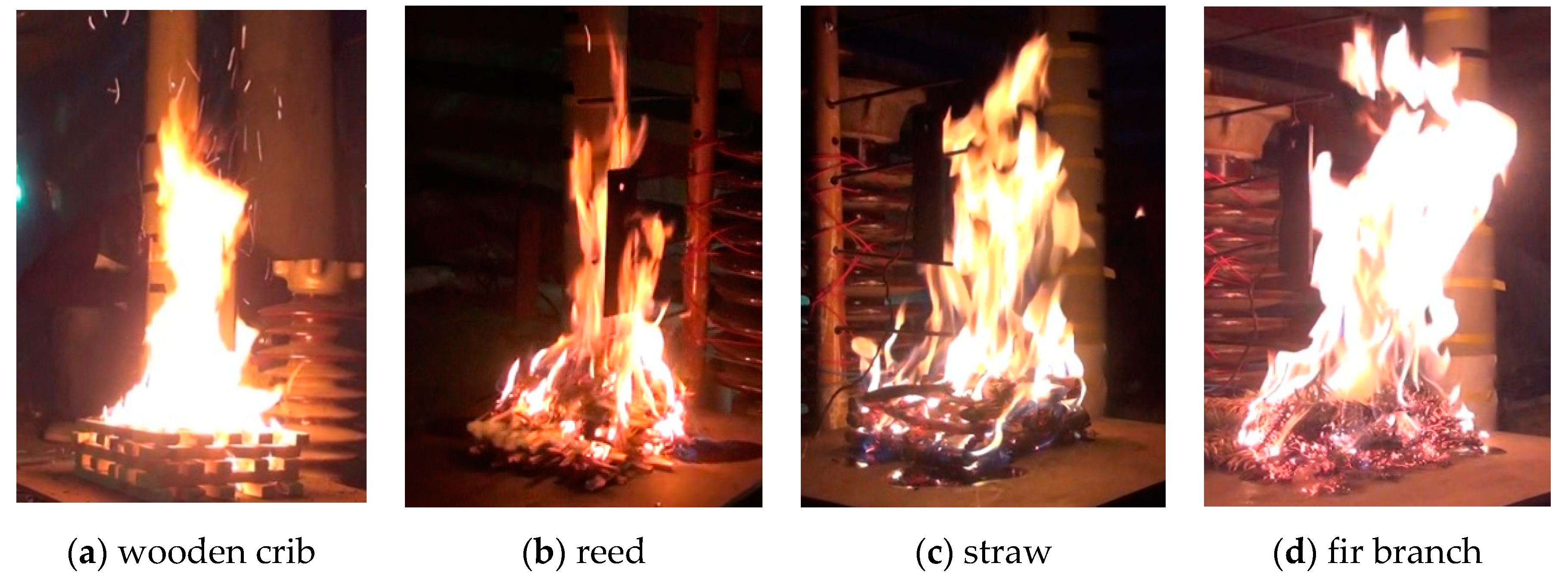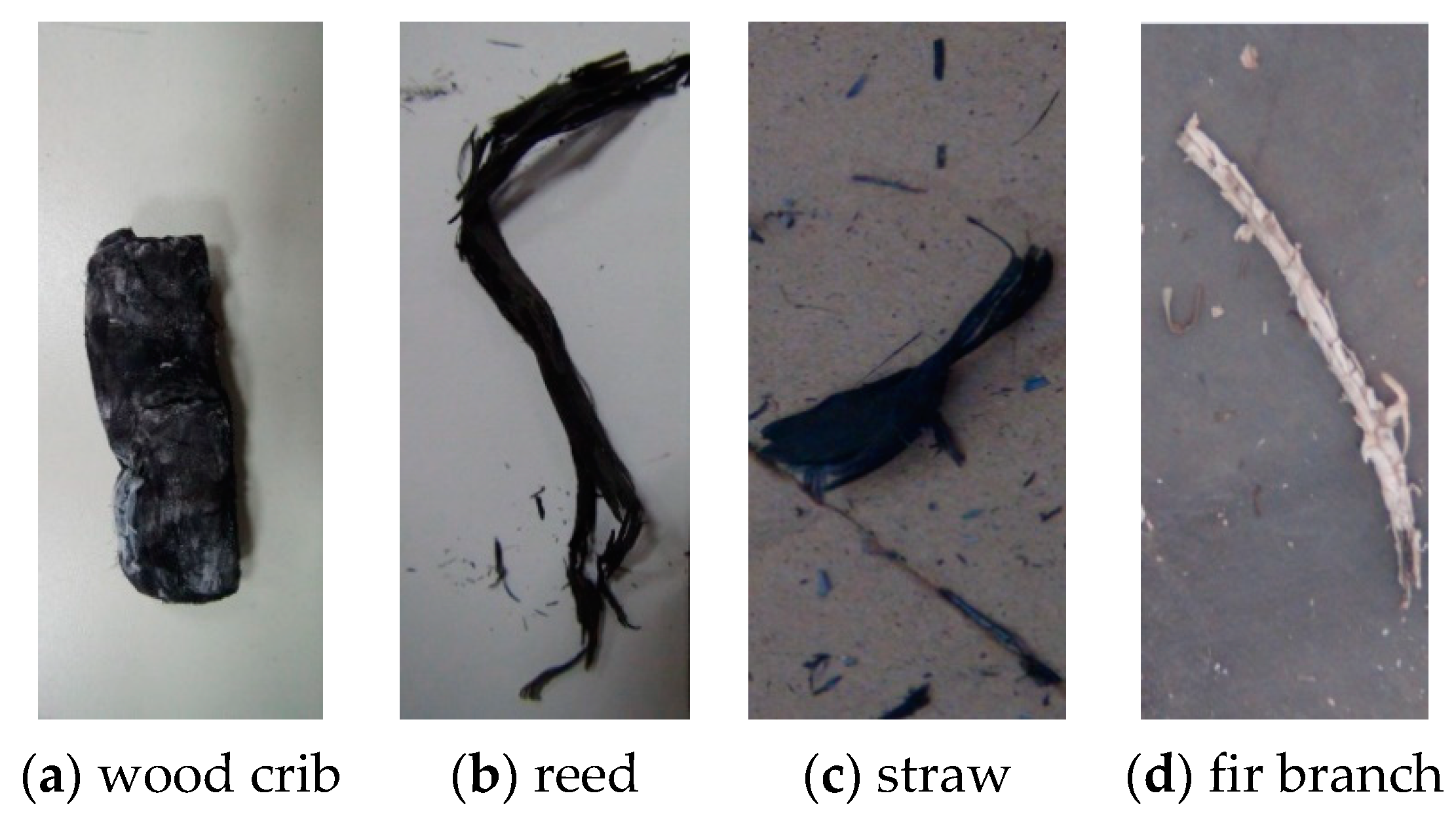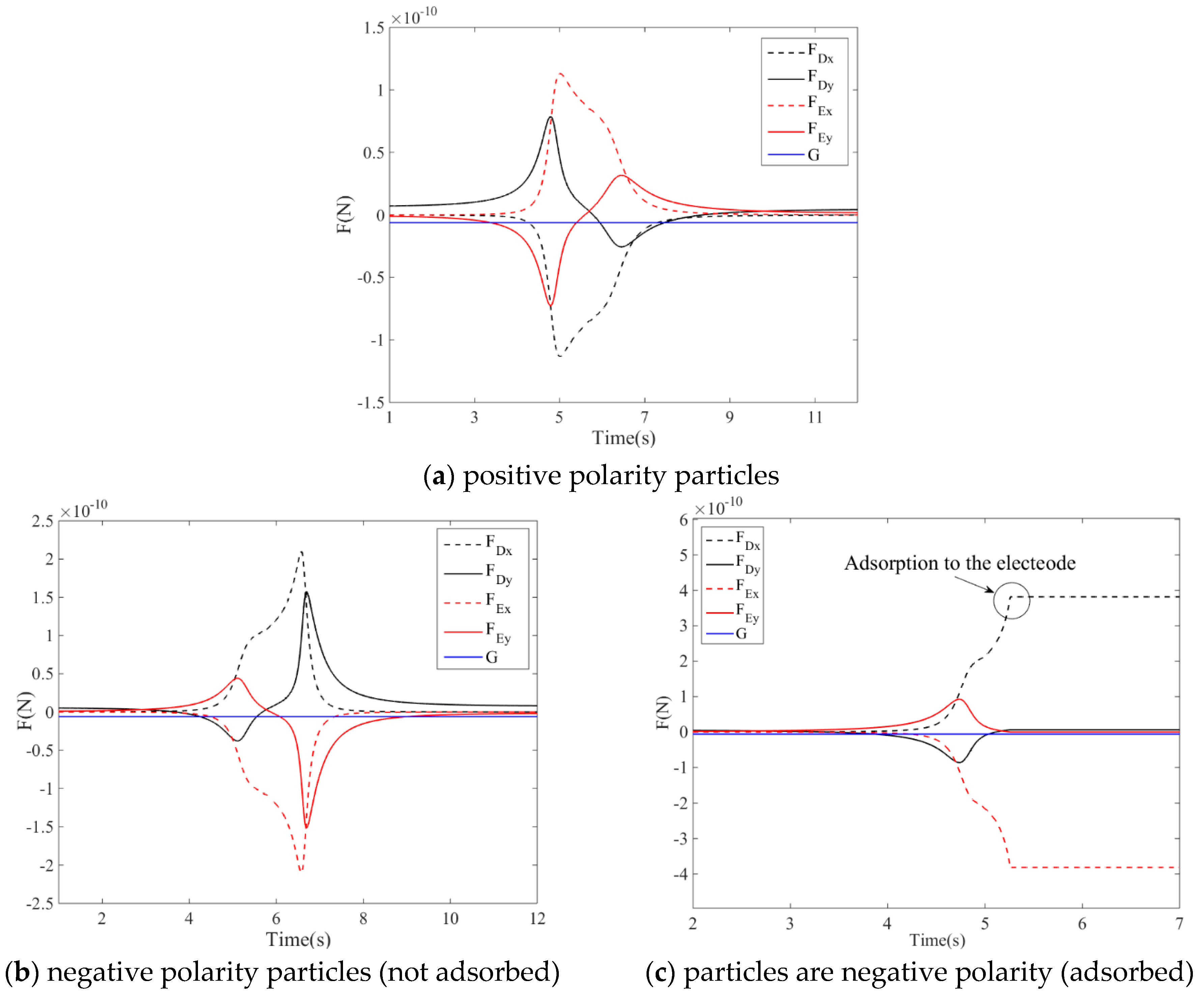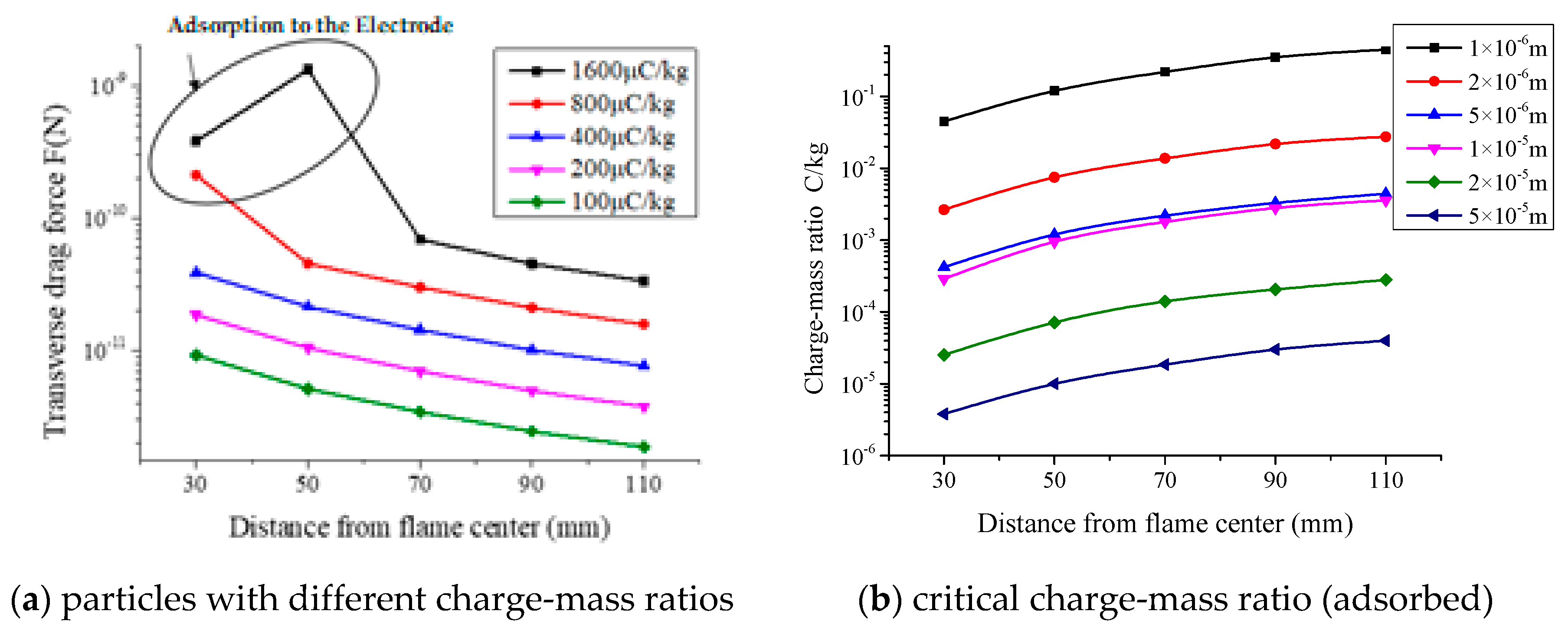Two Dimensional Axisymmetric Simulation Analysis of Vegetation Combustion Particles Movement in Flame Gap under DC Voltage †
Abstract
:1. Introduction
2. Combustion Experiment of Typical Vegetation
2.1. Experiment Arrangement and Steps
2.2. Test Results: Temperature Distribution and Particle Size
3. Simulation Mechanism and Model Establishment
3.1. Mathematical Model of Multiple Physical Fields for the Combustion Particles
3.1.1. Charging Mechanism of Combustion Particles
3.1.2. Motion Control Equation of Combustion Particles
3.2. Coupled Model of Multi-Physical Field
4. Analysis of Simulation Results
4.1. Simulation Results of Temperature and Fluid Field
4.2. Analysis of Force and Motion Characteristics of Combustion Particles
5. Conclusions
Author Contributions
Funding
Conflicts of Interest
References
- Hu, Y.; Liu, K.; Wu, T.; Liu, Y. Analysis of influential factors on operation safety of transmission line and countermeasures. High Volt. Eng. 2014, 40, 3491–3499. [Google Scholar]
- Zhou, Z.Y.; Ai, X.; Lu, J.Z. A real-time analysis approach and its application for transmission-line trip risk due to wildfire disaste. Proc. CSEE 2017, 37, 5321–5330. [Google Scholar]
- Huang, D.; Shu, Y.; Ruan, J.; Hu, Y. Ultra-high voltage transmission in China: Developments, current status and future prospects. Proc. IEEE 2009, 97, 555–583. [Google Scholar] [CrossRef]
- Maabong, K.E.; Mphale, K.; Letsholathebe, D.; Chimidza, S. Measurement of Breakdown Electric Field Strength for Vegetation and Hydrocarbon Flames. J. Electromagn. Anal. Appl. 2018, 3, 53–66. [Google Scholar] [CrossRef]
- Sukhnandan, A.; Hoch, D.A. Fire induced flashovers of transmission lines: Theoretical model. In Proceedings of the IEEE Africon 6th Africon Conference in Africa, George, South Africa, 2–4 October 2002. [Google Scholar]
- Wu, T.; Ruan, J.; Hu, Y.; Liu, B.; Chen, C. Study on forest fire induced breakdown characteristics and mechanism of 500kV transmission line. Proc. CSEE 2011, 31, 163–170. [Google Scholar]
- Peng, L.; Jiangjun, R.; Daochun, H. Study on Breakdown Characteristic and Discharge Model of Conductor-plane Gap Under Typical Vegetation Flame. Proc. CSEE 2016, 36, 4001–4010. [Google Scholar]
- Robledo-Martinez, A.; Guzman, E.; Hernandez, J.L. Dielectric characteristics of a model transmission line in the presence of fire. IEEE Trans. Electr. Insul. 1991, 26, 776–782. [Google Scholar] [CrossRef]
- Mphale, K.M.; Heron, M.; Ketlhwaafetse, R.; Letsholathebe, D.; Casey, R. Interferometric measurement of ionization in a grassfire. Meteorol. Atmos. Phys. 2010, 106, 191–203. [Google Scholar] [CrossRef] [Green Version]
- Naidoo, P.; Swift, D.A. Large particle initiated breakdown of an atmospheric air gap: Relating to AC power line faults caused by sugar cane fires. In Proceedings of the 8 th International Symposium on High Voltage Engineering, Yokohama, Japan, 23–27 August 1993. [Google Scholar]
- Fonseca, J.R.; Tan, A.L.; Silva, R.P.; Monassi, V.; Assuncao, L.A.R.; Junqueira, W.S.; Melo, M.O.C. Effects of agricultural fires on the performance of overhead transmission lines. IEEE Trans. Power Deliv. 1990, 5, 687–694. [Google Scholar] [CrossRef]
- Daochun, H.; Peng, L.; Jiangjun, R.; Yafei, Z.; Tian, W.U. Review on discharge mechanism and breakdown characteristics of transmission line gap under forest fire condition. High Volt. Eng. 2015, 41, 622–632. [Google Scholar]
- Hexun, X.I.; Guangfu, T.A.N.G.; Junzheng, C.A.O.; Jie, L.I.U.; Xiaoguang, W.E.I. Research porgress of electromagnetic field and electromagnetic compatibility of UHVDC converter valves. Proc. CSEE 2012, 32, 1–6. (In Chinese) [Google Scholar]
- Hu, Y. Analysis on operation faults of transmission line and countermeasure. High Volt. Eng. 2007, 33, 1–8. (In Chinese) [Google Scholar]
- Wu, T.; Hu, Y.; Ruan, J.J.; Liu, K.; Liu, T.; Chen, C. Air gap breakdown mechanism of model AC transmission line under forest fire. High Volt. Technol. 2011, 37, 1115–1122. (In Chinese) [Google Scholar]
- Hu, X.; Lu, J.Z.; Zeng, X.J.; Zhang, H.X. Ayalysis on transmission line trip caused by mountion fire and discussion on tripping preventing measure. J. Electr. Power Sci. Technol. 2010, 25, 73–78. (In Chinese) [Google Scholar]
- You, F.; Chen, H.; Zhang, L.; Zhang, Y.; Zhou, J.; Zhu, J. Experimental study on flashover of high-voltage transmission lines induced by wooden crib fire. Proc. CSEE 2011, 31, 192–197. (In Chinese) [Google Scholar]
- Pu, Z.; Xiong, Y.; Wu, T.; Lu, Z.; Fang, C. Simulation Analysis on Influence of Combustion Particles on the Gap Electric Field under DC Voltage. In Proceedings of the 2018 IEEE International Conference on High Voltage Engineering and Application, Athens, Greece, 10–13 September 2018. [Google Scholar]












| Height (cm) | Experimental Data (°C) | Simulation Data (°C) | Deviation (%) |
|---|---|---|---|
| 15 | 465 | 421 | 9.03 |
| 25 | 387 | 365 | 5.68 |
| 35 | 306 | 318 | 3.92 |
© 2019 by the authors. Licensee MDPI, Basel, Switzerland. This article is an open access article distributed under the terms and conditions of the Creative Commons Attribution (CC BY) license (http://creativecommons.org/licenses/by/4.0/).
Share and Cite
Pu, Z.; Zhou, C.; Xiong, Y.; Wu, T.; Zhao, G.; Yang, B.; Li, P. Two Dimensional Axisymmetric Simulation Analysis of Vegetation Combustion Particles Movement in Flame Gap under DC Voltage. Energies 2019, 12, 3596. https://doi.org/10.3390/en12193596
Pu Z, Zhou C, Xiong Y, Wu T, Zhao G, Yang B, Li P. Two Dimensional Axisymmetric Simulation Analysis of Vegetation Combustion Particles Movement in Flame Gap under DC Voltage. Energies. 2019; 12(19):3596. https://doi.org/10.3390/en12193596
Chicago/Turabian StylePu, Ziheng, Chenqu Zhou, Yuyao Xiong, Tian Wu, Guowei Zhao, Baodong Yang, and Peng Li. 2019. "Two Dimensional Axisymmetric Simulation Analysis of Vegetation Combustion Particles Movement in Flame Gap under DC Voltage" Energies 12, no. 19: 3596. https://doi.org/10.3390/en12193596





